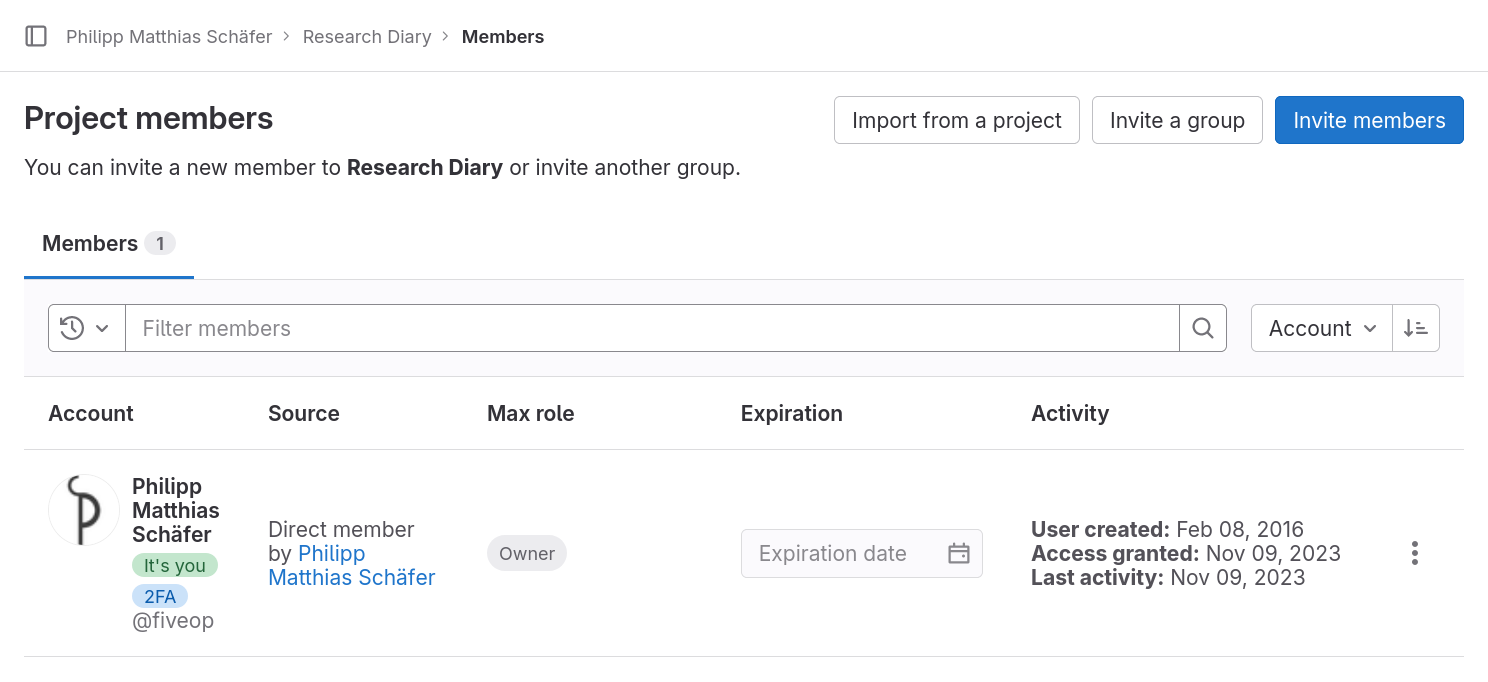Collaboration
Last updated on 2022-04-27 | Edit this page
Estimated time 20 minutes
Overview
Questions
- How can multiple people collaborate on a project?
Objectives
- Explain the concepts of members and roles.
- Add a member to a project.
- Contribute to a project that you are a member of.
Adding Project Members
So far, each of you has created a GitLab project that no one but you can contribute to; depending on the visibility setting, no one but you might be able to even see it.
Git and GitLab can be and is used for one-person projects. But we want our colleagues to contribute to our research diary, when they keep tabs on our experiments for us on the weekends. To achieve this, we will grant others access to our GitLab project.
Using the menu on the left side of the project homepage (or nearly any other project page), we navigate to the project members page hovering over or clicking on “Project Information” and then clicking on “Members” in the submenu. The project member page should look similar to the following screenshot:

On the page we can see the page title, “Project members”, three buttons to the left of the title, and a filterable table of members, currently only listing ourselves.
The table shows our full name and account name, why we are a member of this project, when we got access—at the moment we created the project—what our maximum role is—more on that in a bit—and a disabled membership expiration date widget.
For practice we will all add an instructor to our project and remove them again right away. Click the button labeled “Invite members”, type in the username your instructors provided you with into the search field, make sure that “Guest” is selected as a role, and click the button labeled “Invite”.
After reloading the page, your instructor should now be listed next to you in the table. Unlike in your row, you can change the role and the expiration date of this new entry. There also is a new, red button in this row labeled “Remove member”.
The role determines what the member is allowed to do in the project. A maintainer has full rights, a guest almost none. GitLab’s handbook gives a detailed overview of the different roles’ permissions.
Now, we are going to remove the instructor from your project’s members again. Click the button labeled “Remove member” in the instructor’s row then click the button of the same name in the popup dialog. The page reloads itself and the entry vanishes from the table.
Contribute Changes to Project Repository
Now, everyone should be the member of one of your co-learners’ projects. We will now add an diary entry for imaginary work that we did on their experiments last weekend.
First, we clone their repositories into the directory
rd-colleague.
$ git clone https://gitlab.com/someothernovice/research-diary.git rd-colleagueCloning into 'research-diary'...
Username for 'https://gitlab.com': somenovice
Password for 'https://somenovice@gitlab.com':
remote: Enumerating objects: 3, done.
remote: Counting objects: 100% (3/3), done.
remote: Compressing objects: 100% (2/2), done.
remote: Total 3 (delta 0), reused 0 (delta 0), pack-reused 0Moving into the directory
$ cd rd-colleaguewe check its contents. If your colleague did everything we did, it
should contain a single file, README.md.
$ lsREADME.mdNow we are sure that everything is in order with the cloned repository and we can add our lab entry.
First we create a file, named 2022-03-13.md after the
date on which we did the work, listing the work we did:
* Injected transformational fluid into moss sample.
* Moss turned into several butterflys. SUCCESS!Then we add the file as part of a new commit to the repository:
$ git add 2022-03.13.md
$ git commit -m "Record work on experiment A-13"[main 4eac24c] Record work on experiment A-13
1 file changed, 2 insertions(+)
create mode 100644 2022-03-13.mdMarkdown Lists
Lists can be represented in Markdown by starting their items with a
* character followed by a space. If an list item wraps over
multiple lines, lines following the first are started with sufficient
spaces to align the lines text with the first line’s text.
For example:
* First item
* Second item with enough text to make us wrap to a second
line.We check Git’s log for our commit:
$ git log -n 1commit 4eac24cafbcebc4f0d528bd2e1246a4624265085 (HEAD -> main)
Author: Some Novice <some.novice@example.com>
Date: Thu Mar 17 16:00:23 2022 +0000
Record work on experiment A-13And everything seems to be in order, so we push our change.
$ git pushUsername for 'https://gitlab.com': somenovice
Password for 'https://somenovice@gitlab.com':
Enumerating objects: 4, done.
Counting objects: 100% (4/4), done.
Delta compression using up to 4 threads
Compressing objects: 100% (3/3), done.
Writing objects: 100% (3/3), 388 bytes | 388.00 KiB/s, done.
Total 3 (delta 0), reused 0 (delta 0)
To https://gitlab.com/somenovice/research-diary.git
2dd2c21..4eac24c main -> mainWe have now recorded in pairs lab work we carried out for a colleague during the last weekend. Curious what our colleagues did for us, we navigate back to the directory of our own repository in the shell, for example:
$ cd ../research-diaryThere, we pull the changes that our colleagues previously pushed.
$ git pullUsername for 'https://gitlab.com': somenovice
Password for 'https://somenovice@gitlab.com':
Updating 2dd2c21..4eac24c
Fast-forward
2022-03-13.md | 2 ++
1 file changed, 2 insertions(+)
create mode 100644 2022-03-13.mdFrom the output’s last line, we can already see that a single file,
2022-03-13.md was added. Letting the shell write out the
files contents shows us, what our colleague did:
$ cat 2022-03-13.md* Injected transformational fluid into moss sample.
* Moss turned into several butterflys. SUCCESS!We successfully collaborated through GitLab on a project of text files.
Keypoints
- Adding others as members allows them to directly contribute to your projects
- Members with sufficient rights can independently contribute to repositories
- You update your local repositories relative to the GitLab repository
with the
git pullcommand - You send changes committed in your local repository to the GitLab
repository with the
git pushcommand.
